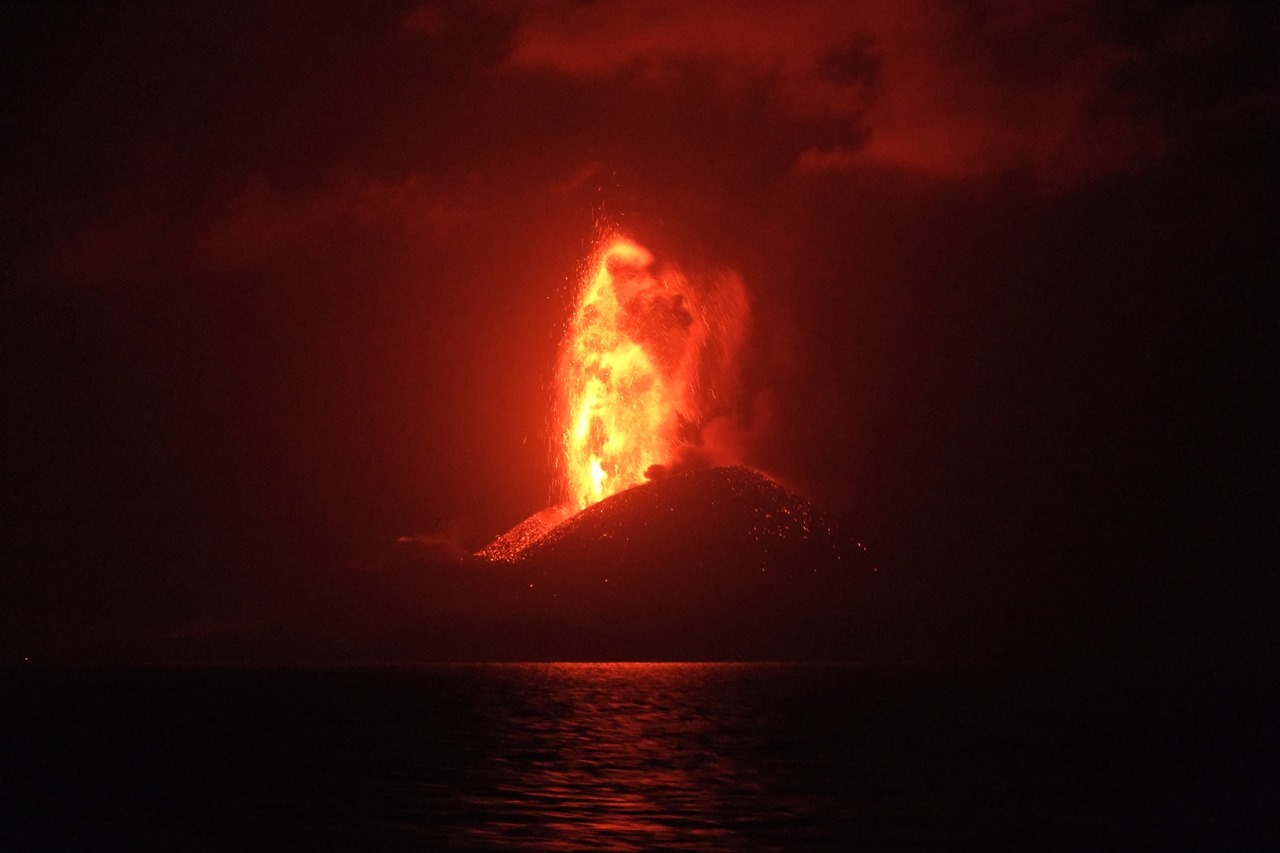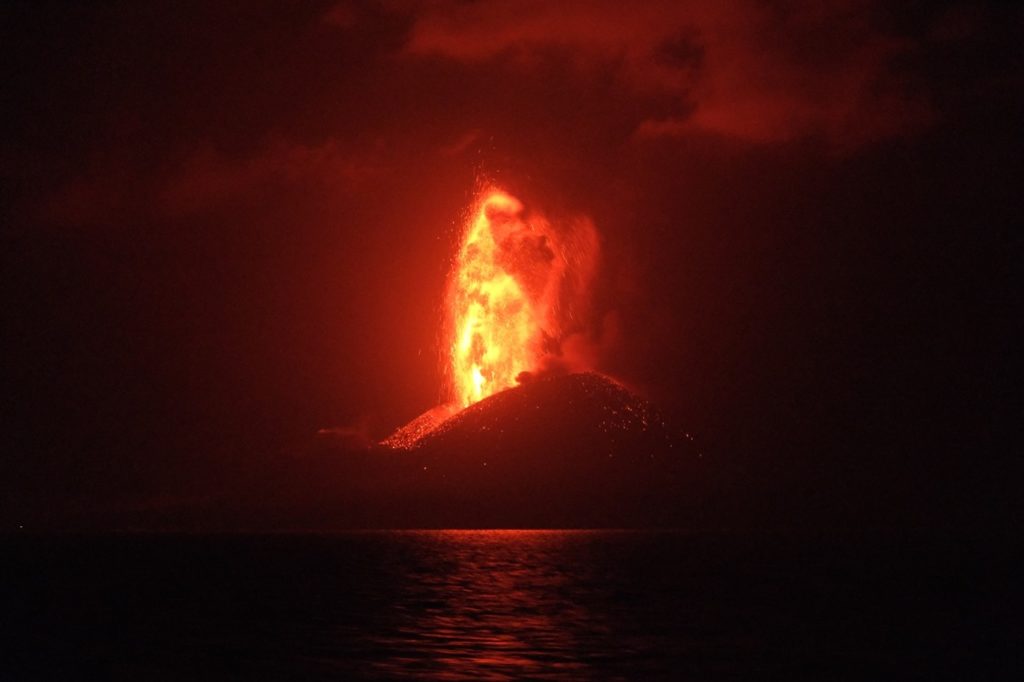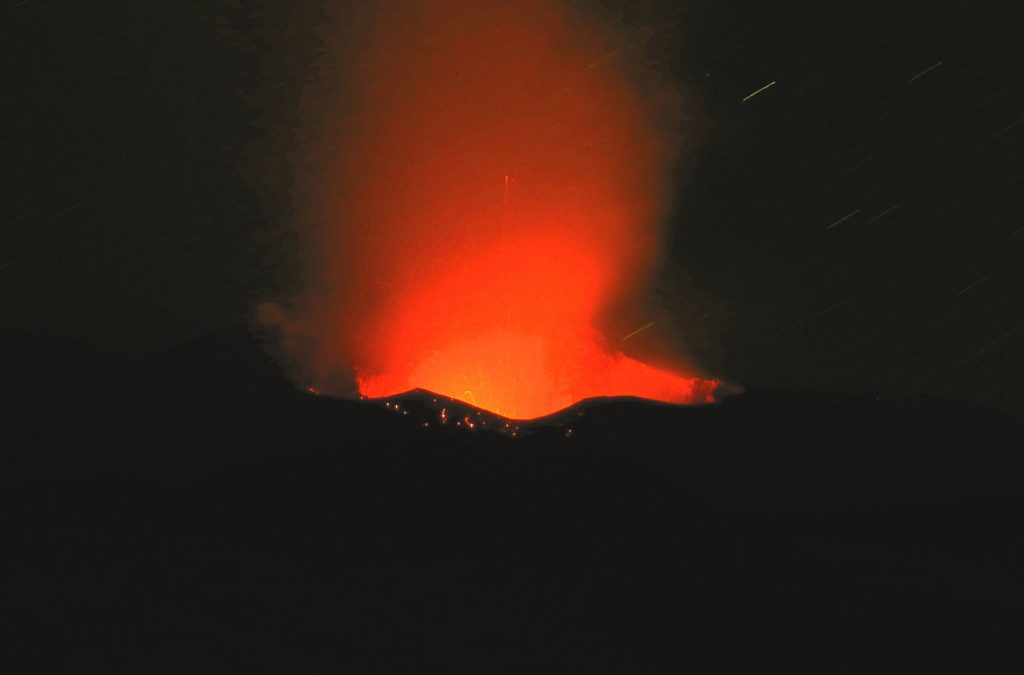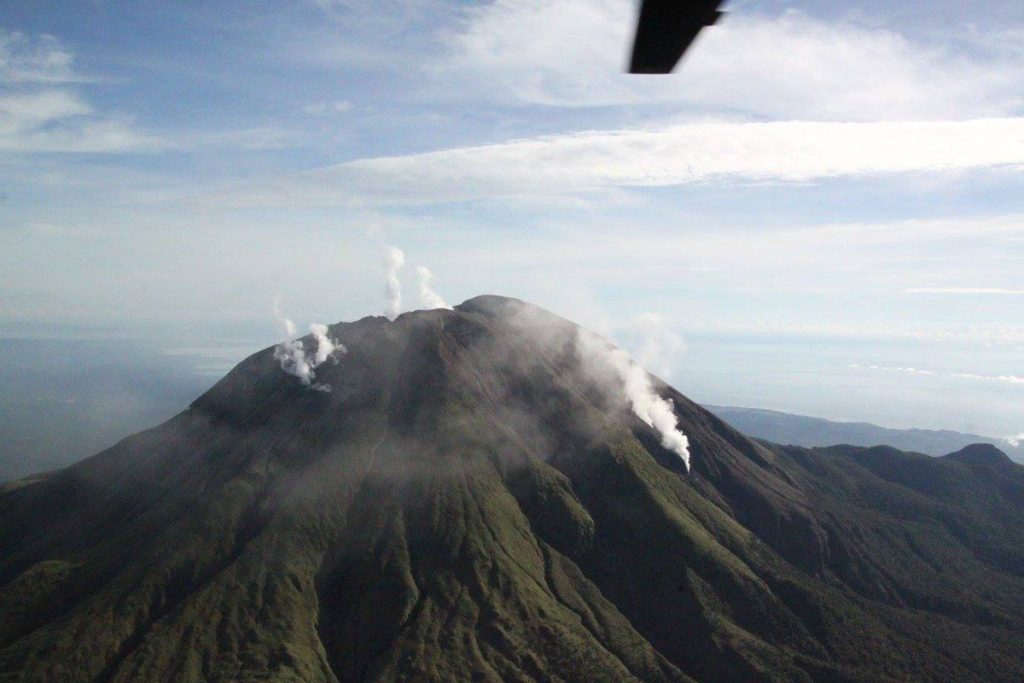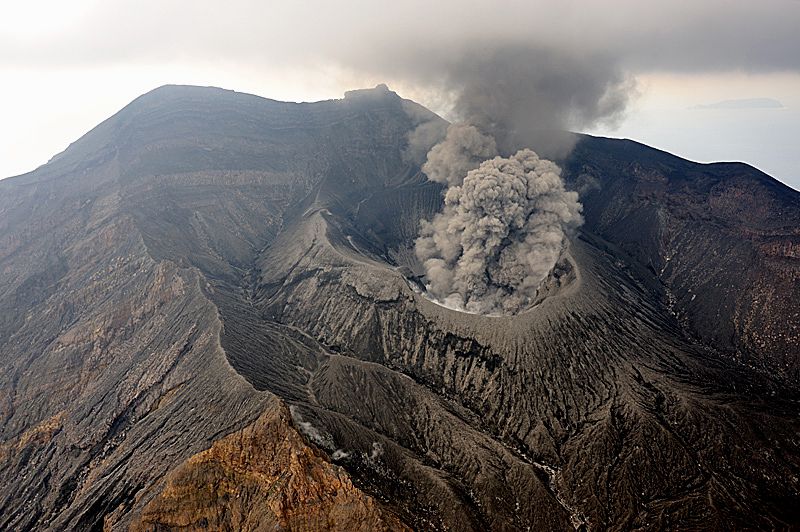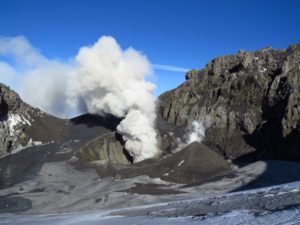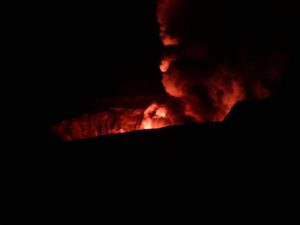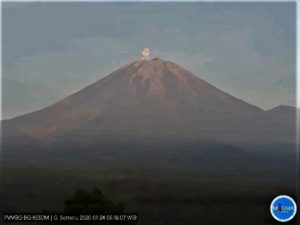July 16 , 2020.
Japan , Nishinoshima :
About the active eruption activity on Nishinoshima:
Observations from the sea made by the oceanic weather observation vessel « Ryofu Maru » on July 11, the active eruption continued on Nishinoshima.
On July 11, the Japanese Meteorological Agency announced that the marine weather observation vessel « Ryofu Maru ».
On Nishinoshima, a large amount of volcanic ash is continuously ejected from the summit crater, demonstrating an active eruption.
It has been confirmed that the fires have continued. In addition, large volcanic blocks are found at the foot of the pyroclastic cone.
At night, hot lava was emitted up to about 200 m above the edge of the crater.
Currently, a crater warning (risk of mountaineering) has been announced on Nishinoshima Island.
In a radius of about 2.5 km around the upper crater, large jets disperse along the trajectory of the eruption
Watch out for stones and lava flows.
The Japanese weather agency has two marine weather observation vessels (Ryofu Maru, Keifu Maru) which are used for ocean observations and ocean weather observations in the Pacific Northwest.
In addition to the above, long-distance observations, ash collections, volcanic gas samples from Itotorijima and Nishinoshima, where volcanic activity is active, as well as volcanic observations such as emission monitoring are also carried out .
Source : JMA.
Read the article (in Japanese) : https://www.jma.go.jp/jma/press/2007/15b/nishinoshima_200715.pdf?fbclid=IwAR3xIzD6X8CFS27KSORUkUVZt40xs2y7fJgjFJDMVGG2j3SLpj8TVngnaQA
Italy / Sicily , Etna :
ETNA PRESS RELEASE [UPDATE n. 60]
The National Institute of Geophysics and Volcanology, Etneo Observatory, reports that from the early hours of the morning, a moderate increase in explosive activity was observed at the craters of New Southeast Crater and Voragine, which feed activity Strombolian of variable character with shreds emitted above the edges of the crater and weak ash emissions which disperse quickly near the summit area.
Regarding the amplitude of the volcanic tremor, there are no significant changes compared to what was communicated previously and shows oscillations, sometimes important, around average and sometimes high values. The location of the tremor source is in the New Southeast Crater (NSEC) area, at an altitude of 2,900 to 3,000 m. The infrasonic activity also shows no significant change and continues to be localized in the New Southeast Crater (NSEC) area.
Regarding the Etna soil deformation monitoring networks (GNSS and inclinometric), they did not show any significant variation.
Other updates will be communicated shortly.
Source et photo : INGV.
Philippines , Bulusan :
BULUSAN VOLCANO BULLETIN 16 July 2020 08:00 A.M.
Bulusan Volcano’s monitoring network recorded forty-six (46) volcanic earthquakes during the 24-hour observation period. Ground deformation data from continuous GPS measurements indicate short-term inflation of the edifice since late February 2020. These parameters indicate that volcanic processes are underway beneath the edifice that may be caused by deep-seated degassing or hydrothermal activity or magmatic intrusion.
Alert Level 1 (Abnormal) status prevails over Bulusan Volcano, which means that it is currently in an abnormal condition. Local government units and the public are reminded that entry into the four-kilometer radius Permanent Danger Zone (PDZ) is strictly prohibited and that vigilance within the two-kilometer Extended Danger Zone (EDZ) on the southeastern sector must be exercised due to the increased possibilities of sudden and hazardous phreatic eruptions. Civil aviation authorities must also advise pilots to avoid flying close to the volcano’s summit as ash from any sudden phreatic eruption can be hazardous to aircraft. Furthermore, people living within valleys and along river/stream channels especially on the southeast, southwest and northwest sector of the edifice should be vigilant against sediment-laden stream flows and lahars in the event of heavy and prolonged rainfall. DOST-PHIVOLCS is closely monitoring Bulusan Volcano’s condition and any new development will be communicated to all concerned stakeholders.
Source et photo : Phivolcs.
Chile , Nevados of Chillan :
Special report of volcanic activity (REAV), Region of Ñuble, volcanic complex of Nevados de Chillán
July 15, 2020, 7:50 p.m. Local time (Continental Chile)
The National Geological and Mining Service of Chile (Sernageomin) publishes the following information, obtained by the surveillance teams of the National Volcanic Surveillance Network (RNVV), processed and analyzed at the South Andean Volcanological Observatory (Ovdas):
The eruptive cycle of the Nevados de Chillán volcanic complex (CVNCh) continues to evolve in a sustained manner and with significant changes. The data provided by the geodetic stations installed around the complex show significant variations in the movements of the stations, in the vertical and horizontal components. It is observed that the 3 closest stations to the crater rose between 2 and 4 cm approximately during the last 5 days, starting a new period of ascent / descent, as previously observed and reported. On the other hand, the horizontal displacements vary between 0.6 and 2.0 cm approximately over the same period. The station furthest from the crater, located more than 10 km from the active crater, shows no significant variations and its elevation during the last month was practically zero. Due to the above, it is concluded that the deformation is concentrated in areas closer to the active crater and therefore that the source of pressure which produces them would be at more superficial levels or related to the ascent and magmatic movements.
https://www.facebook.com/josefauna.biodiversidad/videos/608765640047171/
According to data reported by MIROVA (www.mirovaweb.it), thanks to the analysis of MODIS images, thermal alerts are maintained, with maximum values of 3 MW for July 15, associated with the location of the lava flow .
Thanks to the analysis of SkySat Collect satellite images of July 13, 2020 and Sentinel L2A of July 14, 2020, the evolution of two effusive morphologies currently active in the Nicanor crater is recognized. First, the sustained advance of the lava flow called « L5 » is recorded (REAV Nevados de Chillán volcanic complex, July 2, 2020, 8:20 p.m. local time), with a 268 m extension from the edge of the crater in north direction. An average rate of advance of the L5 lava flow of 0.8 m / h was determined, with values fluctuating between 0.2 m / h and 1.8 m / h. In addition, the development of a new lobe of the lava flow « L5 » is detected, whose extension has exceeded the eastern edge of the Nicanor crater, descending on the eastern slope up to 55 m. Its presence was first detected on July 14 from surveillance cameras and it was verified on thermal camera images that it had higher radiation values than the rest of the volcanic building (similar to casting of lava « L5 »). On the other hand, the progression of another lava body called L6 is observed, which also exceeded the northern limit of the Nicanor crater, extending over 194 m on the northeast slope of the volcanic building and next to the L5 lava flow. The two effusive bodies correspond to the peaks of thermal radiation anomalies according to Sentinel L2A. However, the evolution of « L5 » and « L6 » shows differences in texture, speed and distribution, which is why they have so far been classified as separate items.
Regarding seismic data, the high seismicity production of fluids continues, linked to the extrusion of magmatic materials towards the surface and / or to intermittent explosions, accompanied by the emission of particulate matter of low to moderate heights. In addition, in recent weeks, high energy volcano-tectonic events have been recorded, with local magnitudes (ML) greater than or equal to 3.0.
Source : Sernageomin.
Photo et video : Josefauna.
Japan , Suwanosejima :
29.638°N, 129.714°E
Elevation 796 m
JMA reported that nighttime incandescence at Suwanosejima’s Ontake Crater was occasionally visible during 3-10 July. An eruptive event on 5 July generated a grayish white plume that rose 800 m above the crater rim and ejected material 300 m from the crater. The Tokyo VAAC noted that an ash plume rose to 2.1 km (7,000 ft) a.s.l. and drifted NE on 12 July based on satellite images and JMA information. The Alert Level remained at 2 (on a 5-level scale).
Sources: GVP ,Japan Meteorological Agency (JMA), Tokyo Volcanic Ash Advisory Center (VAAC) .
Photo : H.Seo

